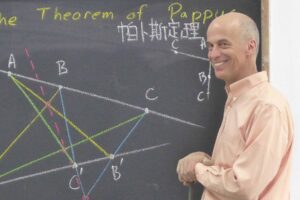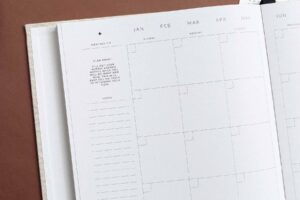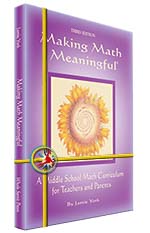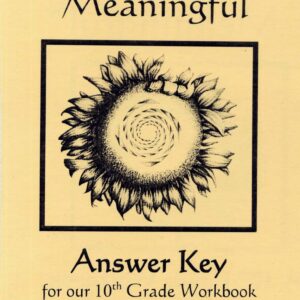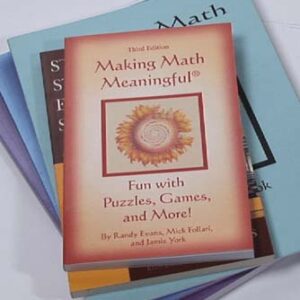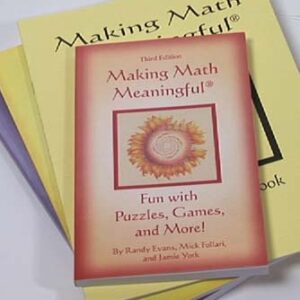Description
About our Source Book for Teaching Middle School Math:
When I started teaching at a Waldorf school, I was surprised to find that there were no textbooks. I was expected to create my own materials. This newfound freedom was both exciting and daunting. I proceeded to research what was happening at other Waldorf schools regarding math curriculum, and have created and discovered much along the way. This book is intended to share with others what I have discovered and developed during this journey. While most of the material is not overly difficult, much of it is foreign, even for math majors. In writing this book, I have assumed that the reader may be weak in math. I hope that with some effort, even the most difficult topic is understandable. This book is both a curriculum guide for middle school math and a source book for great ideas that enrich any teacher’s math lessons.
About the 6th grade workbook. Here are the topics:
The four processes with fractions and decimals
long division (including repeating decimals) • fractions (lots!)
short division • exponents • converting decimals to/from fractions
casting out nines • estimating • square roots • divisibility
unit cost • U.S. measurement and the metric system • formulas
converting repeating decimals to fractions • factors and prime numbers
angle measurement • prime factorization • basic percents
mean/median/mode • pie charts • area and perimeter
percent increase and decrease • tax rate, discount, profit and loss
rate of pay • converting to/from percents • ratios • rate of speed
line graphs • foreign exchange rates • compound fractions.
Here are the Units in our 7th grade workbook:
- Arithmetic. This brief unit mostly reviews sixth grade, and includes fractions, decimals, long division, divisibility, and powers and roots. This theme continues with the review section of the measurement unit.
- Measurement. This unit covers both the US system (hopefully, mostly a review) and the metric system.
- Ratios – Part I. This is one of the most difficult and important units in the workbook. It gets to the essence of what a ratio really is.
- Percents. This builds upon the percents that were introduced in sixth grade.
- Ratios – Part II. This unit builds upon the first unit on ratios. It introduces the idea of irrational numbers, including pi.
- Rates. This includes many rate word problems, such as rate of speed and rate of pay.
- Geometry. This unit builds upon topics introduced in the geometry main lesson, such as: angle theorems, the Pythagorean theorem, and area.
- The Square Root Algorithm (optional). This unit consists of one of the most difficult and most rewarding topics that I have ever taught at any grade level.
- Algebra. This unit appears as the last unit, but is intended to be done in the middle of the year as part of the algebra main lesson.
Here are the Units in our 8th grade workbook:
- Number Bases. This unit is a wonderful way to challenge students and develop real mathematical thinking. Number bases can be part of a main lesson.
- Pythagorean Theorem. Building upon what was begun in seventh grade, this relatively brief unit thoroughly explores the Pythagorean Theorem. It works with the square root algorithm, which should be introduced before beginning the worksheets in this unit.
- Mensuration. “Mensuration” means the study of measurement. In eighth grade, we focus on areas and volumes. Mensuration can be part of a main lesson.
- Percents & Growth. I introduce percents in sixth grade, cover the basics in seventh grade, and then to go into depth in eighth grade. If done well, the students will enter high school having a firm grasp of percents.
- Proportions and Dimensional Analysis. This is the most challenging unit in the book. It builds upon what was introduced during the Measurement unit and Ratios unit in seventh grade. Dimensional Analysis consists mostly of changing units (e.g., “58 pounds is how many kilograms?”). This unit also includes the topics of Density and Rates. There are a few questions that involve Archimedes’ principle, which ought to be covered in the physics main lesson before beginning this unit.
- Algebra. This brief, but important unit can be covered in just three weeks. It is largely a review of what was introduced in the seventh grade Algebra main lesson. Since this unit is so short, and since it is intended to make students practice their algebra skills, it does not include any Group Sheets. In this unit, I expect the work to be done in a very particular manner. With other topics, I encourage students to do the work in their head as much as possible. However, with algebra, I want them to show all of the steps, even if the answer may be immediately obvious to them. This is important so that the students can develop good form and organization skills that will be needed when they study algebra in high school.
- End-of-Year Review. In my sixth and seventh grade workbooks, review is woven into the assignments throughout the year. However, in this eighth grade workbook, review is done at the end of the year. This end-of-year review does not include number bases (since this is not needed for high school) or algebra (since it was just covered in the previous unit).
About String, Straightedge & Shadow, by Julia E. Diggins
This engrossing book reveals these first discoveries about elementary geometry related to the early civilizations of Mesopotamia, Egypt, and Greece. The fabric of the story is woven out of archeological and historical records and legends about the major men of mathematics. By reconstructing the events as they might have happened, the author enables an attentive reader to easily follow the pattern of reasoning that leads to an ingenious proof of the Pythagorean theorem, an appreciation of the significance of the Golden Mean in art and architecture, and the construction of the five regular solids. Whether you are learning geometry for the first time, teaching it to your students, or parents helping your children through their first geometry course, this is a must read for everyone! You will be fascinated with the graphic illustrations and written description of how the knowledge and wisdom of so many cultures helped shape our civilization today.
Abuot our Puzzle & Game Book
Are you looking for a new math challenge for your students? Do you need a resource of ideas that will give your students the opportunity to experience the thrill of mathematics? And, what about providing a good puzzle or game that will give everyone the understanding of true problem-solving? Randy Evans, Mick Follari and Jamie York have combined their knowledge and skills to create a puzzle and game book that is a perfect reference for the math classroom and for middle school and high school teachers everywhere.
You should also consider signing up for…
Our Grade-Specific Online Workshop: The Art of Teaching 6th Grade Math
Our Grade-Specific Online Workshop: The Art of Teaching 7th Grade Math
Our Grade-Specific Online Workshop: The Art of Teaching 8th Grade Math

